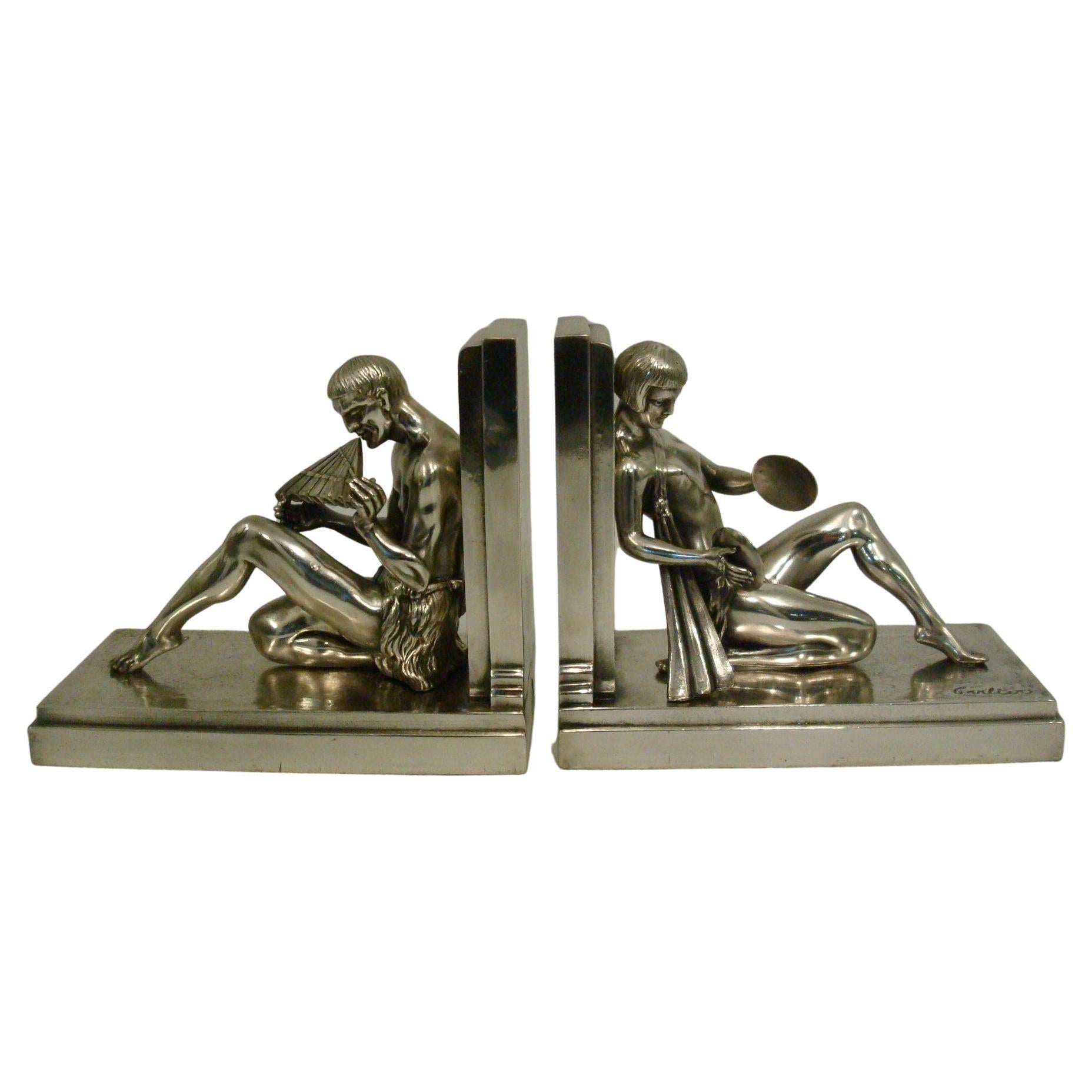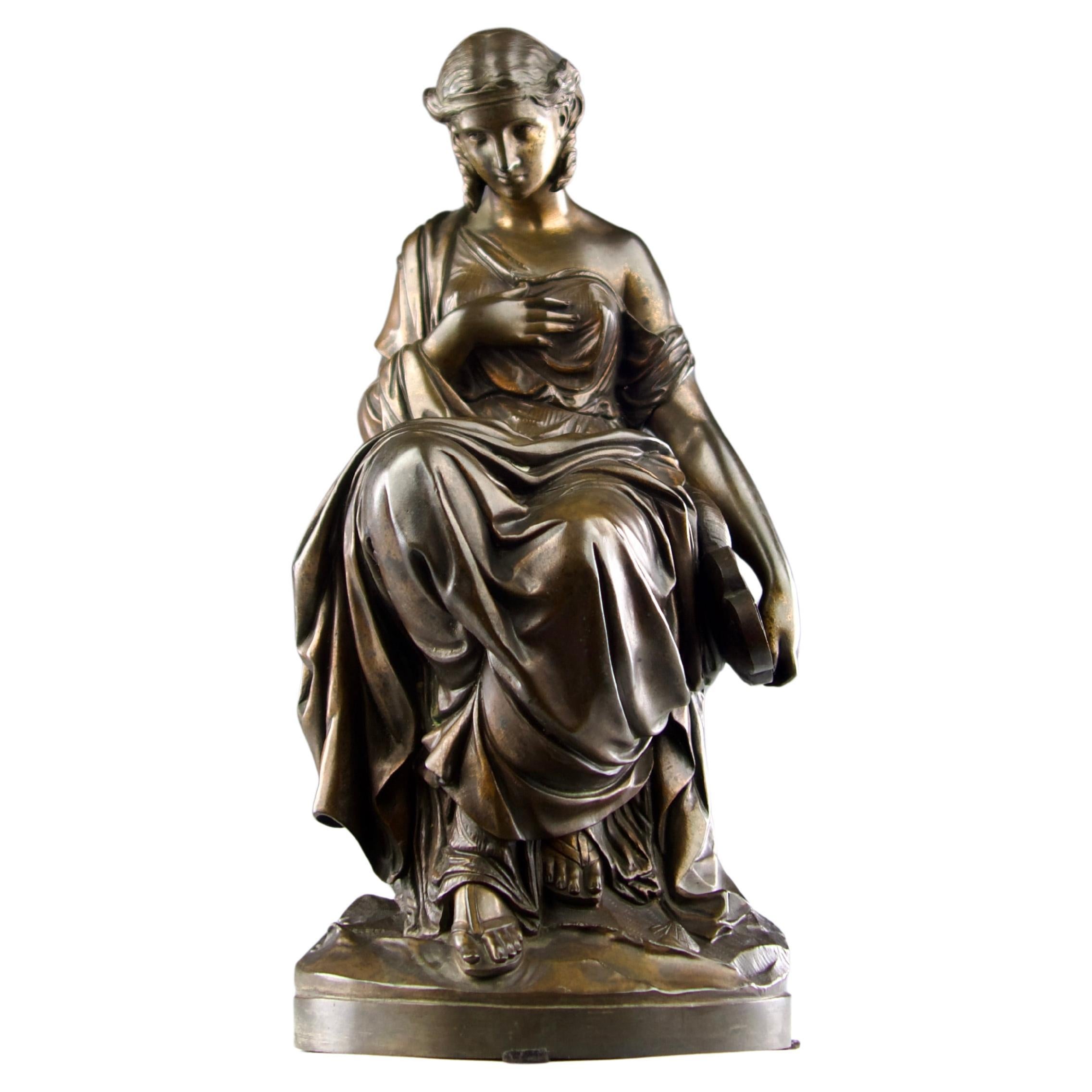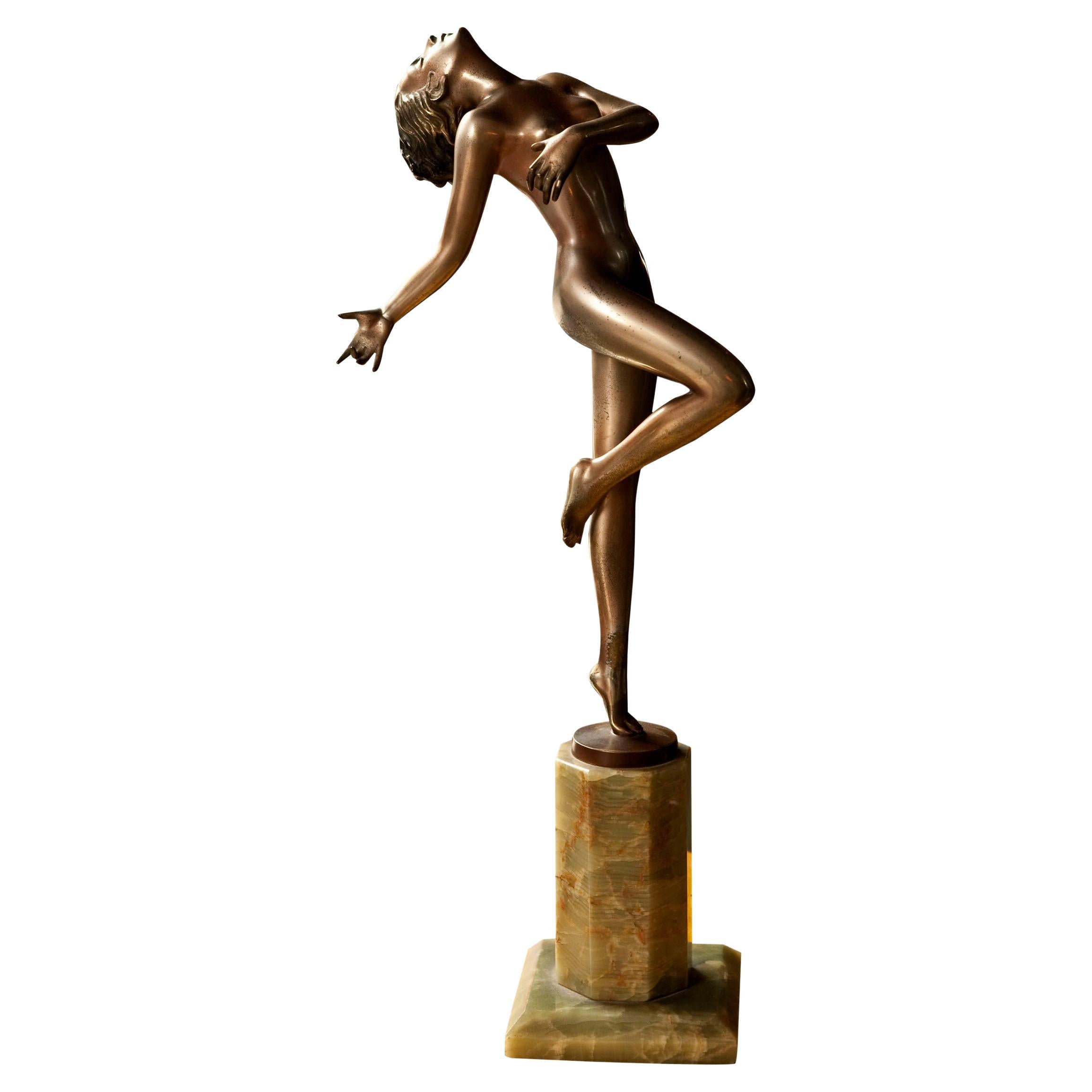Items Similar to Art Deco Sculpture Signed Carlier
Video Loading
Want more images or videos?
Request additional images or videos from the seller
1 of 14
Art Deco Sculpture Signed Carlier
About the Item
Large art deco illuminating sculpture, circa 1930.
Spelter sculpture on marble base.
Opalescent glass ball soap bubble.
In perfect condition and electrified
Length: 17,5 cm
Diameter: 15 cm
Height: 71 cm
Depth: 10,5 cm
Weight: 7kg
Sculptor - lives in Paris
born in Cambrai on January 3, 1849 and died in Paris on April 11, 1927
Joseph Carlier was born in a house on rue de la Prison, where Cambrai town hall now stands. His father is a cutler and a musician in his spare time. He wants to see his son become an architect or engineer of arts and crafts.
Pupil at the school of the Brothers, he will follow the courses of the municipal school of drawing under the watchful eye of his professors Berger, father and son. His father, fearing the ups and downs of an artist's life, was unenthusiastic about his son's professional choice. It was with the support of his mother that in 1864 he joined the workshop of the ornamental sculptor from Cambrai Lecaron, where he learned the trade by sculpting the stones of the cathedral of Cambrai. On this occasion, the young apprentice falls from a scaffolding and owes his salvation only to the strap of his bag which keeps him suspended from the mast.
He went to Paris to visit the Universal Exhibition of 1867 which reinforced his vocation as an artist. Not receiving any financial support from his parents, he had to do odd jobs and was hired by a furniture manufacturer in the Faubourg Saint-Antoine. Then he returned to Cambrai to follow the courses of the academic school in the studio of René Fache. A studious and diligent student, his teacher convinced Carlier's parents to let him settle in Paris to enter the École des Beaux-Arts. He obtained a scholarship from the city of Cambrai in 1869 and was admitted to Jules Cavelier's studio.
The professor provides a rigorously academic teaching. The war of 1870 interrupted his studies. Exempted from military service, he made a trip to his parents, then joined the Montrouge volunteers. He experienced his baptism of fire at the outposts of Bagneux and Buzenval, saw the orientalist painter Henri Regnault fall, himself received three shots and narrowly avoided the loss of his right arm. Proposed by his colonel for the cross he will say to him: "Give me the medal, that's enough". He received the military medal by decree of December 31, 1871, on the report of the Minister of War.
He attends the events of the Commune and goes in search of other horizons. Armed with a pistol and fifteen francs, he left for Spain, which he traveled on foot for six months. Hiring his services en route to stonemasons. Back in Paris he joined the studio of François Jouffroy, then entered the Académie Julian in the studio of Henri Chapu where he found his friend from Valenciennes, Léon Fagel.
Having never ceased to take an interest in his hometown and a member of several associations, he sat on the Cambrai reconstruction committee and took part in all the Parisian meetings where Cambrésiens were present.
On his death, the eulogy is pronounced by the poet Dévigne, A. Dorchain and the mayor of Cambrai G. Desjardins. Fernand Créteur reads his biography.
He is buried in Paris in the Montparnasse cemetery, near his parents-in-law.
works
In 1874, he made his debut at the Salon and subsequently exhibited every year. As a token of gratitude, he donated his first important work to the city of Cambrai. This is the stone statue of the Cambresian chronicler Enguerrand de Monstrelet, which he made in 1876 and which was erected in a public garden. It was destroyed by bombing in 1944.
In 1877, he designed his statue of The Resurrection which adorns the tomb of his sister-in-law in the Père-Lachaise cemetery in Paris. This work was commissioned from him for a funerary monument in the Recoleta cemetery in Buenos Aires, and he agreed to make a copy.
He exhibited Gilliat struggling with octopuses, which earned him a second medal at the Salon of 1879, then Before the Stone Age, which enabled him to obtain a travel grant and to visit Italy in 1881. In Florence, he modeled the sketch of The Blind and the Paralytic for which he was awarded the first medal at the Salon of 1883.
In 1885, he requested, without obtaining it, a workshop at the Mobilier national or at the quai de l'Alma for his sculpture work. In 1886, he applied for a block of marble, which was refused.
In 1888, he was commissioned to work on sculpture for the decoration of the Roubaix industrial school or the Universal Exhibition of 1889, which was unsuccessful.
In 1889, after his gold medal at the Universal Exhibition in Paris, he decided to transform his Gilliat which he exhibited at the Salon of 1890. His work was purchased by the State for the Luxembourg Museum. Having become a member of the jury of the Salon des artistes français, he had the rules revised. This same year, his request for a work of sculpture will be closed for the reason that in 1889 he was bought a statue at the Salon for the sum of 10,000 francs5. A new request in 1894 obtained the same answer.
At the end of the century, the city of Condé-sur-l'Escaut pre-selected him, as well as Léonie Duquesnoy and Jules Louis Mabille, to carry out the Monument de la Clairon, the native actress of this commune. It is finally Henri Gauquié who realizes the work.
He sculpts feminine grace with his masterpiece Le Miroir6, exhibited at the Universal Exhibition of 1900. This statue represents the character of Chrysis from the novel Aphrodite by Pierre Louÿs.
The follow-up given to his request to work on a sculpture for the Universal Exhibition of 1900, made in 1898, remains unknown.
For Condé-sur-Escaut, in 1907 he created the Monument to General Léon de Poilloüe de Saint-Mars, French general of division.
In 1904, he won a worldwide subscription launched for the creation of a Monument to the Vilmorins, erected in 1908 in a Parisian square.
He was called to Algiers in 1912 to reproduce the features of the Duke of Cars, the general of the conquest of 1830, and also to make the medallion of General Maurice Bailloud, the successor of the previous conqueror, for the realization of a bronze plaque. affixed to the obelisk of the War Memorial of the African Army, erected on the heights of Fort l'Empereur, inaugurated by the Governor General of Algeria Charles Lutaud, on October 21, 1912 and destroyed with explosives for the safety of the inhabitants of Algiers in 1943.
When the First World War broke out, he devoted himself to the work of refugees from the North and, as president of the Amicale de Cambrai, he devoted himself during the four years of the conflict with his friend Devignes to helping the people of Cambrésis. , driven out by war.
In 1916, Senator Paul Bersez thanked the Minister of Fine Arts for the purchase of a work [Which?] by the artist. In 1918, Carlier asked the Minister of Fine Arts for a post of Inspector of Fine Arts and informed him that some of the bronze statues placed in the gardens of Cambrai had been damaged by the bombardments of May 1944. He collaborated with the architect Castex has a monumental fountain project for the city of Reims.
After the war, he made bronzes of hairy people, copies of some of which adorn war memorials, in particular the statue of a soldier from the Great War bearing on its base "We don't pass!" which glorifies the fighters of Verdun.
- Creator:Émile Nestor Joseph Carlier 1 (Artist)
- Dimensions:Height: 27.96 in (71 cm)Width: 6.11 in (15.5 cm)Depth: 4.14 in (10.5 cm)
- Style:Art Deco (Of the Period)
- Materials and Techniques:
- Place of Origin:
- Period:
- Date of Manufacture:1930
- Condition:
- Seller Location:NANTES, FR
- Reference Number:1stDibs: LU7403234570732
About the Seller
No Reviews Yet
Vetted Seller
These experienced sellers undergo a comprehensive evaluation by our team of in-house experts.
1stDibs seller since 2022
19 sales on 1stDibs
Typical response time: 1 hour
- ShippingRetrieving quote...Ships From: NANTES, France
- Return PolicyA return for this item may be initiated within 14 days of delivery.
More From This SellerView All
- Art Deco Swallow Sculpture Signed RuchotBy Jean Charles RuchotLocated in NANTES, FRArt deco sculpture in silvered bronze, "Swallow in flight". Signed Ruchot with founder's stamp Marcel Guillemard, stamped "Bronze". On a black marble base, note a shine on the marble...Category
Vintage 1920s French Art Deco Animal Sculptures
MaterialsMarble, Bronze
- Art Deco Bronze Sculpture Signed Dakon (Stefan))By Stefan DakonLocated in NANTES, FRCold-painted Austrian bronze. Dancer with her hands raised on a port marble base. Signed Dakon on the marble. Total height: 47 cm Width: 26 cm Depth: 11 cm Weight: 5 Kg Stefan Dako...Category
Mid-20th Century Austrian Art Deco Figurative Sculptures
MaterialsMarble, Bronze
- Art Deco Bronze Sculpture Cuckoo Tits Signed M. GuillemardBy Marcel GuillemardLocated in NANTES, FRArt deco bronze circa 1930 representing two crested titmice with brown and green patina on a portor marble base signed on the bronze M. Guillemard for Marcel Guillemard. In perfect c...Category
Mid-20th Century French Art Deco Animal Sculptures
MaterialsMarble, Bronze
- Art Deco sculpture 2 Dancers with Cymbals signed LimousinBy LimousinLocated in NANTES, FRArt deco sculpture circa 1930. Regulates silver and gold cold patina. All on a portor marble base. Small restoration on a cymbal. Signed on Limousin ...Category
Mid-20th Century French Art Deco Figurative Sculptures
MaterialsMarble, Spelter
- Art Deco Panther Signed PlagnetLocated in NANTES, FRPanther around 1930 in black patina spelter on an oriental breccia marble base signed "Plagnet" on the marble. In perfect condition. Length: 67 cm Width: 22 cm Height: 28 cm Weight...Category
Mid-20th Century French Art Deco Animal Sculptures
MaterialsMarble, Spelter
- Becquerel Art Deco Bronze SculptureBy André Vincent BecquerelLocated in NANTES, FRArt Deco sculpture in silvered bronze bird on branch of vines. The whole thing is on a black marble base (surfin from Belgium). Signed Bacquerel and stamped "bronze". Note two shine...Category
Mid-20th Century Art Deco Animal Sculptures
MaterialsMarble, Bronze
You May Also Like
- Art Deco Emile Carlier Figural Goat Bookends, France 1925By Émile Nestor Joseph Carlier 1Located in Buenos Aires, OlivosArt Deco Bookends. Emile Joseph Nestor Carlier, (French, 1849-1927). Figural Goat Bookends. Silvered Metal mounted over Green Marble bases. Nice and heavy.Category
Early 20th Century French Art Deco Bookends
MaterialsMarble, Metal
- Art Deco Musical Figural Bookends by Emile Carlier, France 1925By Émile Nestor Joseph Carlier 1Located in Buenos Aires, OlivosArt Deco Bookends by Emile Joseph Nestor Carlier, French, c 1925, cast in silvered metal as a man clad in a loin cloth playing the pans flute and a similarly clad woman playing the cymbals, covered in a silver plating signed "Carlier" on the base, "Fabrication Francaise...Category
Early 20th Century French Art Deco Bookends
MaterialsMetal
- Emile Carlier, Bronze Sculpture of Sappho and her Lyre by the Sea, 19th CenturyBy Émile Nestor Joseph Carlier 1, Albinet & CoulonLocated in PARIS, FRSuperb and rare bronze sculpture by Émile Nestor Joseph Carlier (1849-1927) of the Archaic Greek poetess Sappho. This sculpture was smelted by the Albinet & Coulon foundry. It is sig...Category
Antique 1880s French Romantic Figurative Sculptures
MaterialsBronze
- Art Déco sculpture ceramic signed odyvLocated in CHALON-SUR-SAÔNE, FRFrench Art Deco ceramic sculpture by BERLOT-MUSSIER (Vierzon, 1929-1939), France, 1930s. Young Lady among flowers in the style of René Buthaud in colored crackle glaze ceramic. Measu...Category
Early 20th Century European Art Deco Figurative Sculptures
MaterialsCeramic
- Sculpture, 1920, Art Deco, Sign LorenzlLocated in Ciudad Autónoma Buenos Aires, CSign: Lorenz Josef (Austria, 1892-1950). Sculptor, known for its dancers. Worked along with Goldscheider in Vienna. Materials: Bronxe and onyx with the original patina We have specialized in the sale of Art Deco and Art Nouveau and Vintage styles since 1982. If you have any questions we are at your disposal. Pushing the button that reads 'View All From Seller'. And you can see more objects to the style for sale. Josef Lorenzl (1 September 1892 – 15 August 1950) was an Austrian sculptor and ceramicist of the Art Deco period, the same era as Ferdinand Preiss (1882–1943) and Demetre Chiparus (1886–1947). Lorenzl was born on 1 September 1882 in Vienna, Austria and died there on 15 August 1950. Little is known about his early years, but more is known about his later life. Lorenzl started his career working at a foundry at the Vienna Arsenal where he learned the techniques of bronze casting. The Vienna Arsenal was a military storage...Category
Vintage 1920s Austrian Art Deco Figurative Sculptures
MaterialsOnyx, Bronze
- Art Deco Sculpture in Plaster signed S MelaniBy Salvatore MelaniLocated in SAINTE-COLOMBE, FRArt Deco Sculpture in Plaster signed S Melani A delightful art deco sculpture by Italian Salvatore Melani (1902 - 1934) of a woman sitting with her hand out...Category
Early 20th Century French Art Deco Figurative Sculptures
MaterialsPlaster
Recently Viewed
View AllMore Ways To Browse
Hermes British Columbia
Hermes Jean Sandals
Hermes Men Trainers
Hermes Mens Trainers
Huffy Vintage
Humphrey Hopper
I Tessier
Isidore Konti
J Art Iron Bench
James Siebert
Jasper Sword Pendant
Jasperware Wedgwood Canopic Jar
Jean de Roncourt On Sale
Jeno Murai
Joseph Seigenthaler
Juan Hidalgo
Juan Miguel Quinones
Karava Vase





